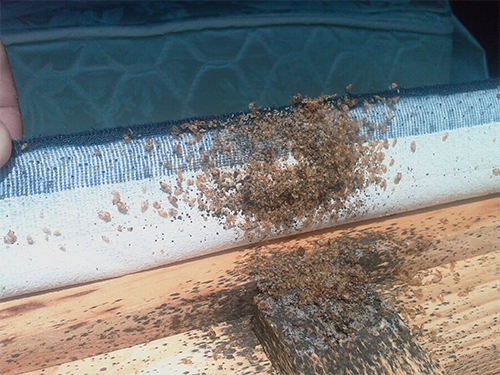Specialist A1 Bed Bug Exterminator in Houston - Efficient Solutions
Specialist A1 Bed Bug Exterminator in Houston - Efficient Solutions
Blog Article
Recognizing the Lifecycle of Parasites for Targeted Control Approaches
Recognizing the lifecycle of bugs is a fundamental facet of effective insect administration approaches. With a much deeper understanding of exactly how pests progress and thrive, tailored control strategies can be created to address specific points in their lifecycle, eventually leading to more effective pest monitoring outcomes.
Value of Understanding Insect Lifecycle
Understanding the lifecycle of insects is crucial for developing effective and targeted control approaches in insect management. By comprehending the various stages an insect goes through from egg to grownup, pest control experts can identify vulnerable factors in the lifecycle where treatment can be most effective.
In addition, identifying the details environmental conditions required for each stage of the parasite's lifecycle can lead choices on habitat adjustment or exemption methods to interrupt the lifecycle and decrease parasite populaces. This knowledge enables pest monitoring professionals to implement aggressive procedures instead of depending solely on responsive treatments, resulting in more sustainable and long-term insect control solutions. Inevitably, a comprehensive understanding of pest lifecycles encourages insect control specialists to tailor their approaches successfully, reducing ecological effects and maximizing control results.
Key Stages in Pest Advancement
To effectively apply targeted control strategies in insect monitoring, a crucial element hinges on adequately identifying and understanding the essential stages in insect advancement. Parasite growth generally consists of a number of vital phases that are crucial for their lifecycle and management. The initial stage is the egg stage, where pests lay eggs that later hatch into larvae. Larvae then progress into pupae, a stage where they undergo transformation before becoming grown-up parasites. Understanding these phases is crucial as it aids in determining vulnerable points in the lifecycle where control measures can be most effective.

Susceptabilities in Insect Lifecycle
Throughout the different stages of a pest's lifecycle, unique susceptabilities emerge that can be purposefully targeted for effective control procedures. One important susceptability depends on the egg phase, where insects are often a lot more susceptible to specific pesticides or organic control agents because of their soft external shell, making them much easier targets for treatment. Additionally, the nymph or larval phase provides susceptabilities as pests go through quick growth and advancement, calling for high power usage that can be made use of by disrupting their food sources or introducing development preventions. Pupal phases, characterized by immobility and improvement, supply a window for targeted control with physical obstacles or specific treatments that hinder successful introduction. Adult insects, while a lot more resistant due to their reproductive ability, can still be vulnerable during breeding or egg-laying tasks, which can be interfered with via scent catches or sanitation strategies. Understanding these vulnerabilities in the insect lifecycle is vital you could check here for establishing my website reliable and exact control approaches that effectively manage bug populations while lessening ecological impact.
Applying Targeted Control Steps

Applying targeted control procedures typically includes a multi-faceted approach. This may consist of habitat alteration to make the environment much less hospitable to insects, such as getting rid of standing water for mosquito control or securing entry factors for rats. Furthermore, biological control techniques can be made use of, where natural predators or virus are introduced to keep parasite populations in check.
Integrated Insect Management (IPM) strategies that combine various control actions in a coordinated and sustainable way are frequently the most reliable in accomplishing lasting bug monitoring objectives. By implementing targeted control measures based on a complete understanding of insect lifecycles, bug populations can be efficiently managed while lessening threats to human health and wellness and the atmosphere.
Boosted Parasite Administration Practices

In addition, the consolidation of organic control agents, such as all-natural killers or pathogens of insects, can help in reducing reliance on chemical pesticides and advertise a much more well balanced community. Applying physical barriers and traps can also become part of boosted pest management methods, using safe and targeted services for bug control. In addition, using pheromones and other semiochemicals can interrupt pest breeding patterns and Source interaction, leading to minimized parasite populaces in time.
Final Thought
By determining essential stages in pest growth and susceptabilities in their lifecycle, targeted control procedures can be executed to reduce pest populations. Boosted bug administration practices can aid minimize the reliance on broad-spectrum pesticides and advertise even more sustainable and eco friendly parasite control techniques.
Understanding the lifecycle of pests is crucial for creating effective and targeted control approaches in pest management. By understanding the different phases a bug goes through from egg to grownup, bug control professionals can determine vulnerable factors in the lifecycle where intervention can be most successful. Eventually, a detailed understanding of insect lifecycles encourages insect control practitioners to customize their strategies successfully, minimizing ecological impacts and making best use of control end results.
By executing targeted control actions based on a complete understanding of pest lifecycles, parasite populaces can be effectively managed while decreasing risks to human health and wellness and the setting.
By recognizing key stages in bug growth and susceptabilities in their lifecycle, targeted control measures can be carried out to decrease parasite populations.
Report this page